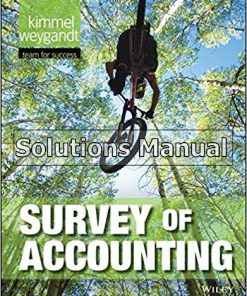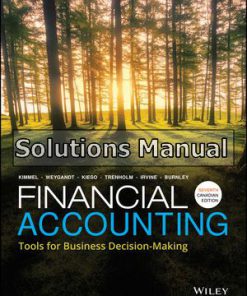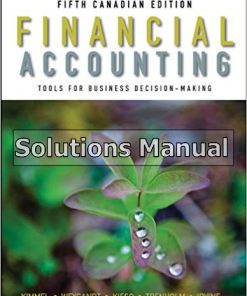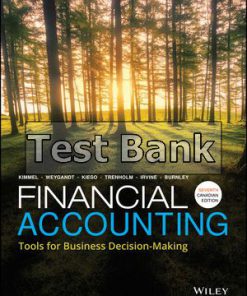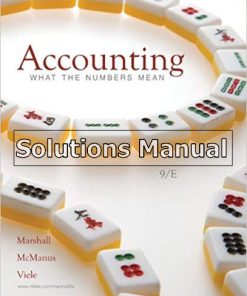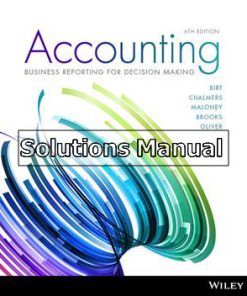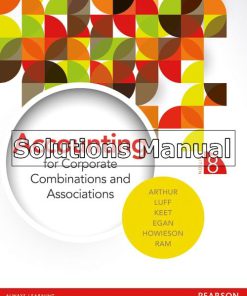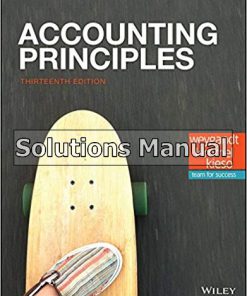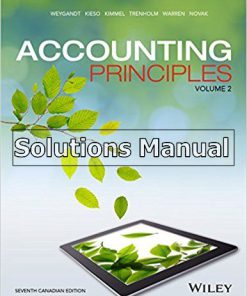Financial Accounting International Student 7th Edition Kimmel Solutions Manual
$26.50$50.00 (-47%)
Financial Accounting International Student 7th Edition Kimmel Solutions Manual.
You may also like
Financial Accounting International Student 7th Edition Kimmel Solutions Manual

Product details:
- ISBN-10 : 1118379721
- ISBN-13 : 978-1118379721
- Author: P. D. Kimmel, D. E. Kieso J. J. Weygandt
Students get accounting when using Kimmel Financial Accounting with WileyPLUS because we make learning accounting easy and accessible for today’s different types of learners. Written in a concise, clear, and conversation way, Kimmel Financial Accounting provides just the right amount of information students need to come to class prepared, while powerful visuals and Interactive Tutorials make complex accounting concepts possible to absorb quickly. Starting with the big picture of financial statements first, Paul Kimmel shows students why financial accounting is important to their everyday lives, business majors, and future careers. This best-selling financial accounting text is known for the most relevant and easy to understand examples, while teaching students the accounting cycle through the lens of one consistent story of Sierra Corp, an outdoor adventure company. The automatically graded WileyPLUS problem-solving experience imitates a blank sheet of paper with type-ahead for entering account titles, so that students use recall memory when they practice or do homework online. More students get accounting when using Kimmel Financial Accounting with WileyPLUS, because they can Read It, See It, Do It – Get It.
Table contents:
1 Accounting in Action 1-1
Knowing the Numbers 1-1
1.1 Accounting Activities and Users 1-3
Who Uses Accounting Data 1-4
Data Analytics 1-5
1.2 The Building Blocks of Accounting 1-7
Ethics in Financial Reporting 1-7
Accounting Standards 1-8
Measurement Principles 1-9
Assumptions 1-9
1.3 The Accounting Equation 1-12
Assets 1-12
Liabilities 1-13
Equity 1-13
1.4 Analyzing Business Transactions 1-14
Accounting Transactions 1-15
Transaction Analysis 1-16
Summary of Transactions 1-21
1.5 Financial Statements 1-22
Income Statement 1-24
Retained Earnings Statement 1-24
Statement of Financial Position 1-24
Statement of Cash Flows 1-25
Comprehensive Income Statement 1-25
Appendix 1A: Career Opportunities in Accounting 1-27
Public Accounting 1-27
Private Accounting 1-28
Governmental Accounting 1-28
Forensic Accounting 1-28
A Look at U.S. GAAP 1-48
2 The Recording Process 2-1
Accidents Happen: Bank of Taiwan 2-1
2.1 Accounts, Debits, and Credits 2-2
The Account 2-2
Debits and Credits 2-3
Equity Relationships 2-7
Summary of Debit/Credit Rules 2-7
2.2 The Journal 2-8
The Recording Process 2-8
The Journal 2-9
2.3 The Ledger and Posting 2-11
The Ledger 2-11
Posting 2-13
Chart of Accounts 2-14
The Recording Process Illustrated 2-14
Summary Illustration of Journalizing and Posting 2-20
2.4 The Trial Balance 2-22
Limitations of a Trial Balance 2-23
Locating Errors 2-23
Currency Signs and Underlining 2-23
A Look at U.S. GAAP 2-47
3 Adjusting the Accounts 3-1
What Was Your Profit? 3-1
3.1 Accrual-Basis Accounting and Adjusting Entries 3-2
Fiscal and Calendar Years 3-3
Accrual- versus Cash-Basis Accounting 3-3
Recognizing Revenues and Expenses 3-3
The Need for Adjusting Entries 3-6
Types of Adjusting Entries 3-6
3.2 Adjusting Entries for Deferrals 3-7
Prepaid Expenses 3-7
Unearned Revenues 3-11
3.3 Adjusting Entries for Accruals 3-14
Accrued Revenues 3-14
Accrued Expenses 3-16
Summary of Basic Relationships 3-19
3.4 Adjusted Trial Balance and Financial Statements 3-22
Preparing the Adjusted Trial Balance 3-23
Preparing Financial Statements 3-23
Appendix 3A: Alternative Treatment of Deferrals 3-26
Prepaid Expenses 3-27
Unearned Revenues 3-28
Summary of Additional Adjustment Relationships 3-29
Appendix 3B: Financial Reporting Concepts 3-30
Qualities of Useful Information 3-30
Assumptions in Financial Reporting 3-31
Principles in Financial Reporting 3-31
Cost Constraint 3-32
A Look at U.S. GAAP 3-58
4 Completing the Accounting Cycle 4-1
Speaking the Same Language: IASB 4-1
4.1 The Worksheet 4-3
Steps in Preparing a Worksheet 4-3
Preparing Financial Statements from a Worksheet 4-11
Preparing Adjusting Entries from a Worksheet 4-12
4.2 Closing the Books 4-13
Preparing Closing Entries 4-13
Posting Closing Entries 4-15
Preparing a Post-Closing Trial Balance 4-17
4.3 The Accounting Cycle and Correcting Entries 4-20
Summary of the Accounting Cycle 4-20
Reversing Entries—An Optional Step 4-20
Correcting Entries—An Avoidable Step 4-20
4.4 Classified Statement of Financial Position 4-24
Intangible Assets 4-25
Property, Plant, and Equipment 4-26
Long-Term Investments 4-26
Current Assets 4-26
Equity 4-27
Non-Current Liabilities 4-27
Current Liabilities 4-28
Appendix 4A: Reversing Entries 4-30
Reversing Entries Example 4-30
A Look at U.S. GAAP 4-59
5 Accounting for Merchandise Operations 5-1
Who Doesn’t Shop?: Carrefour 5-1
5.1 Merchandising Operations and Inventory Systems 5-3
Operating Cycles 5-3
Flow of Costs 5-4
5.2 Recording Purchases Under a Perpetual System 5-7
Freight Costs 5-8
Purchase Returns and Allowances 5-9
Purchase Discounts 5-10
Summary of Purchasing Transactions 5-11
5.3 Recording Sales Under a Perpetual System 5-11
Sales Returns and Allowances 5-13
Sales Discounts 5-14
Data Analytics and Credit Sales 5-15
5.4 The Accounting Cycle for a Merchandising Company 5-16
Adjusting Entries 5-16
Closing Entries 5-17
Summary of Merchandising Entries 5-17
5.5 Financial Statements for a Merchandiser 5-19
Income Statement 5-19
Classified Statement of Financial Position 5-23
Appendix 5A: Worksheet for a Merchandising Company 5-25
Using a Worksheet 5-25
Appendix 5B: Periodic Inventory System 5-26
Determining Cost of Goods Sold Under a Periodic System 5-27
Recording Merchandise Transactions 5-28
Recording Purchases of Merchandise 5-28
Recording Sales of Merchandise 5-29
Journalizing and Posting Closing Entries 5-29
Using a Worksheet 5-31
Appendix 5C: Adjusting Entries for Credit Sales with Returns and Allowances 5-33
Data Analytics in Action 5-54
A Look at U.S. GAAP 5-58
6 Inventories 6-1
“Where Is That Spare Bulldozer Blade?”:
Komatsu 6-1
6.1 Classifying and Determining Inventory 6-2
Classifying Inventory 6-2
Determining Inventory Quantities 6-4
6.2 Inventory Methods and Financial Effects 6-7
Specific Identification 6-7
Cost Flow Assumptions 6-8
Financial Statement and Tax Effects of Cost Flow Methods 6-11
Using Inventory Cost Flow Methods Consistently 6-13
6.3 Effects of Inventory Errors 6-14
Income Statement Effects 6-14
Statement of Financial Position Effects 6-15
6.4 Inventory Statement Presentation and Analysis 6-16
Presentation 6-16
Lower of Cost or Net Realizable Value 6-16
Financial Analysis and Data Analytics 6-17
Appendix 6A: Inventory Cost Flow Methods in Perpetual Inventory Systems 6-21
First-In, First-Out (FIFO) 6-21
Average-Cost 6-22
Appendix 6B: Estimating Inventories 6-23
Gross Profit Method 6-23
Retail Inventory Method 6-24
Appendix 6C: LIFO Inventory Method 6-25
Data Analytics in Action 6-47
A Look at U.S. GAAP 6-50
7 Fraud, Internal Control, and Cash 7-1
Minding the Money at Nick’s: Nick’s Steakhouse and Pizza 7-1
7.1 Fraud and Internal Control 7-2
Fraud 7-3
Internal Control 7-3
Principles of Internal Control Activities 7-4
Data Analytics and Internal Controls 7-10
Limitations of Internal Control 7-10
7.2 Cash Controls 7-11
Cash Receipts Controls 7-11
Cash Disbursements Controls 7-14
Petty Cash Fund 7-16
7.3 Control Features of a Bank Account 7-19
Making Bank Deposits 7-19
Writing Checks 7-20
Electronic Banking 7-21
Bank Statements 7-21
Reconciling the Bank Account 7-22
7.4 Reporting Cash 7-27
Cash Equivalents 7-27
Restricted Cash 7-28
Data Analytics in Action 7-46
A Look at U.S. GAAP 7-49
Appendix 9A: Exchange of Plant Assets 9-26
Loss Treatment 9-27
Gain Treatment 9-27
Data Analytics in Action 9-47
A Look at U.S. GAAP 9-50
8 Accounting for Receivables 8-1
Are You Going to Pay Me—or Not?: BNP Paribas 8-1
8.1 Recognition of Accounts Receivable 8-2
Types of Receivables 8-3
Recognizing Accounts Receivable 8-3
8.2 Valuation and Disposition of Accounts Receivable 8-5
Valuing Accounts Receivable 8-5
Disposing of Accounts Receivable 8-12
8.3 Notes Receivable 8-15
Determining the Maturity Date 8-16
Computing Interest 8-16
Recognizing Notes Receivable 8-17
Valuing Notes Receivable 8-17
Disposing of Notes Receivable 8-17
8.4 Presentation and Analysis 8-20
Presentation 8-20
Analysis 8-20
Data Analytics and Receivables Management 8-21
Data Analytics in Action 8-38
A Look at U.S. GAAP 8-41
9 Plant Assets, Natural Resources, and Intangible Assets 9-1
How Much for a Ride to the Beach?: Rent-A-Wreck 9-1
9.1 Plant Asset Expenditures 9-2
Determining the Cost of Plant Assets 9-3
Expenditures During Useful Life 9-6
9.2 Depreciation Methods 9-7
Factors in Computing Depreciation 9-8
Depreciation Methods 9-9
Component Depreciation 9-13
Depreciation and Income Taxes 9-14
Revaluation of Plant Assets 9-14
Revising Periodic Depreciation 9-15
9.3 Plant Asset Disposals 9-16
Retirement of Plant Assets 9-17
Sale of Plant Assets 9-18
9.4 Natural Resources and Intangible Assets 9-19
Natural Resources and Depletion 9-20
Intangible Assets 9-21
9.5 Statement Presentation and Analysis 9-25
Presentation 9-25
Analysis 9-26
10 Current Liabilities 10-1
Financing His Dreams: Wilbert Murdock 10-1
10.1 Accounting for Current Liabilities 10-2
What Is a Current Liability? 10-2
Notes Payable 10-3
Value-Added and Sales Taxes Payable 10-4
Unearned Revenues 10-5
Salaries and Wages 10-6
Current Maturities of Long-Term Debt 10-8
10.2 Reporting and Analyzing Current Liabilities 10-8
Reporting Uncertainty 10-8
Reporting of Current Liabilities 10-10
Analysis of Current Liabilities 10-11
A Look at U.S. GAAP 10-27
11 Non-Current Liabilities 11-1
Are We Living on Borrowed Time? 11-1
11.1 Overview of Bonds 11-2
Types of Bonds 11-3
Issuing Procedures 11-3
Bond Trading 11-4
Determining the Market Price of a Bond 11-5
11.2 Accounting for Bond Transactions 11-7
Issuing Bonds at Face Value 11-7
Discount or Premium on Bonds 11-8
Issuing Bonds at a Discount 11-9
Issuing Bonds at a Premium 11-10
Redeeming Bonds 11-12
11.3 Accounting for Non-Current Liabilities 11-13
Long-Term Notes Payable 11-13
Lease Liabilities 11-15
11.4 Reporting and Analyzing Non-Current Liabilities 11-16
Presentation 11-16
Analysis 11-16
Debt and Equity Financing 11-17
Appendix 11A: Effective-Interest Method of Bond Amortization 11-19
Amortizing Bond Discount 11-19
Amortizing Bond Premium 11-21
Appendix 11B: Straight-Line Amortization 11-22
Amortizing Bond Discount 11-22
Amortizing Bond Premium 11-23
A Look at U.S. GAAP 11-40
12 Corporations: Organization, Share Transactions, and Equity 12-1
To the Victor Go the Spoils: adidas 12-1
12.1 The Corporate Form of Organization 12-2
Characteristics of a Corporation 12-3
Forming a Corporation 12-6
Shareholder Rights 12-6
Share Issue Considerations 12-8
Corporate Capital 12-10
12.2 Accounting for Share Transactions 12-12
Accounting for Ordinary Shares 12-12
Accounting for Preference Shares 12-14
Accounting for Treasury Shares 12-15
12.3 Accounting for Dividends and Splits 12-19
Accounting for Cash Dividends 12-19
Dividend Preferences 12-21
Accounting for Share Dividends 12-24
Accounting for Share Splits 12-26
12.4 Reporting and Analyzing Equity 12-28
Retained Earnings 12-28
Presentation of Statement of Financial Position 12-29
Analysis 12-31
Appendix 12A: Statement of Changes in Equity 12-32
Appendix 12B: Book Value—Another per Share Amount 12-33
Book Value per Share 12-33
Book Value versus Market Price 12-34
Data Analytics in Action 12-58
A Look at U.S. GAAP 12-61
13 Investments 13-1
Playing for Fun and Profit: Sony 13-1
13.1 Debt Investments 13-2
Why Companies Invest 13-3
Classification and Measurement of Investments 13-4
Accounting for Debt Investments 13-4
13.2 Share Investments 13-7
Holdings of Less than 20% 13-7
Holdings Between 20% and 50% 13-9
Holdings of More than 50% 13-10
13.3 Valuing and Reporting Investments 13-12
Categories of Securities 13-12
Statement of Financial Position Presentation 13-18
Presentation of Realized and Unrealized Gain or Loss 13-19
Classified Statement of Financial Position 13-20
Appendix 13A: Preparing Consolidated Financial Statements 13-22
Consolidated Statement of Financial Position 13-22
Consolidated Income Statement 13-26
A Look at U.S. GAAP 13-43
14 Statement of Cash Flows 14-1
What Should We Do with This Cash?: Keyence 14-1
14.1 Statement of Cash Flows: Usefulness and Format 14-3
Usefulness of the Statement of Cash Flows 14-3
Classification of Cash Flows 14-3
Significant Non-Cash Activities 14-5
Format of the Statement of Cash Flows 14-5
14.2 Preparing the Statement of Cash Flows—Indirect Method 14-7
Indirect and Direct Methods 14-7
Indirect Method—Computer Services International 14-8
Step 1: Operating Activities 14-9
Summary of Conversion to Net Cash Provided by Operating Activities—Indirect Method 14-12
Step 2: Investing and Financing Activities 14-13
Step 3: Net Change in Cash 14-14
14.3 Using Cash Flows to Evaluate a Company 14-17
Free Cash Flow 14-17
Appendix 14A: Statement of Cash Flows—Direct Method 14-19
Step 1: Operating Activities 14-21
Step 2: Investing and Financing Activities 14-25
Step 3: Net Change in Cash 14-26
Appendix 14B: Statement of Cash Flows—T-Account Approach 14-26
Data Analytics in Action 14-48
A Look at U.S. GAAP 14-51
15 Financial Analysis: The Big Picture 15-1
Making Money the Old-Fashioned Way: Li Ka-shing 15-1
15.1 Basics of Financial Statement Analysis 15-2
Need for Comparative Analysis 15-3
Tools of Analysis 15-3
Horizontal Analysis 15-3
Vertical Analysis 15-6
15.2 Ratio Analysis 15-9
Liquidity Ratios 15-9
Profitability Ratios 15-13
Solvency Ratios 15-16
Summary of Ratios 15-18
15.3 Sustainable Income 15-20
Discontinued Operations 15-21
Changes in Accounting Principle 15-22
Comprehensive Income 15-22
A Look at U.S. GAAP 15-48
Appendix A Specimen Financial Statements: Taiwan Semiconductor Manufacturing Company, Limited A-1
Appendix B Specimen Financial Statements: Nestlé SA B-1
Appendix C Specimen Financial Statements: Delfi Limited C-1
Appendix D Specimen Financial Statements: Apple Inc. D-1
Appendix E Time Value of Money E-1
E.1 Interest and Future Values E-1
Nature of Interest E-1
Future Value of a Single Amount E-3
Future Value of an Annuity E-5
E.2 Present Value Concepts E-7
Present Value Variables E-7
Present Value of a Single Amount E-8
Present Value of an Annuity E-10
Time Periods and Discounting E-12
Present Value of a Long-Term Note or Bond E-12
E.3 Using Financial Calculators E-15
Present Value of a Single Sum E-15
Present Value of an Annuity E-16
Useful Applications of the Financial Calculator E-17
Appendix F Accounting for Partnerships F-1
F.1 Forming a Partnership F-1
Characteristics of Partnerships F-2
Organizations with Partnership Characteristics F-3
Advantages and Disadvantages of Partnerships F-4
The Partnership Agreement F-5
Accounting for a Partnership Formation F-5
F.2 Accounting for Net Income or Net Loss F-6
Dividing Net Income or Net Loss F-6
Partnership Financial Statements F-9
F.3 Liquidation of a Partnership F-10
No Capital Deficiency F-11
Capital Deficiency F-12
F.4 Admissions and Withdrawals of Partners F-14
Admission of a Partner F-15
Withdrawal of a Partner F-18
Appendix G Subsidiary Ledgers and Special Journals G-1
G.1 Subsidiary Ledgers G-1
Subsidiary Ledger Example G-2
Advantages of Subsidiary Ledgers G-3
G.2 Special Journals G-4
Sales Journal G-5
Cash Receipts Journal G-7
Purchases Journal G-11
Cash Payments Journal G-13
Effects of Special Journals on the General Journal G-16
Cybersecurity: A Final Comment G-17
Subject Index I-1
Company Index I-13
People also search:
financial accounting ifrs
financial accounting seventh edition
financial accounting theory 7th edition
financial accounting for mbas 7th edition
|
international financial management 7th edition
|


